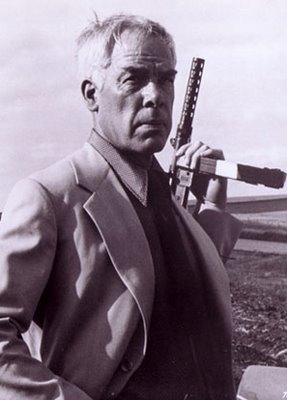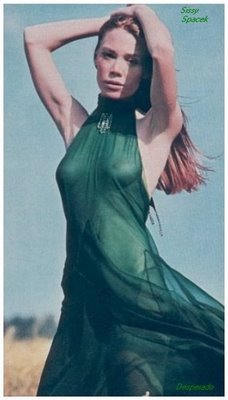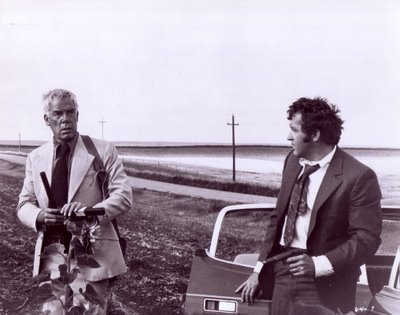halloween list 2006
 Stepping out to get my mail, I can’t help but get excited as I notice a slight chill in the air, and that the trees are erupting with color. This can only mean one thing: Halloween is coming! Aside from our anniversary and birthdays, there is no holiday more important or special on the calendar of our relationship. And while passing the milestones of our time together or our time on earth is an intimate ritual between my girlfriend and I, it is the excitement of October that strengthens our love. After all, what other holiday is celebrated (by adults) through watching a pile of dearly loved movies? The cineplex was the temple of my childhood, so this is like celebrating the High Holidays for me. One might counter by pointing out the assorted movies associated with Christmas, but I’m hard pressed to think of any that doesn’t make me want to pluck my eyeballs out and stuff them in my ears (especially if you exclude “Black Christmas”(1974;Clark), “Silent Night, Bloody Night”(1974; Gershuny) and “The Nightmare Before Christmas”(1993;Selick) as being inappropriate).
Stepping out to get my mail, I can’t help but get excited as I notice a slight chill in the air, and that the trees are erupting with color. This can only mean one thing: Halloween is coming! Aside from our anniversary and birthdays, there is no holiday more important or special on the calendar of our relationship. And while passing the milestones of our time together or our time on earth is an intimate ritual between my girlfriend and I, it is the excitement of October that strengthens our love. After all, what other holiday is celebrated (by adults) through watching a pile of dearly loved movies? The cineplex was the temple of my childhood, so this is like celebrating the High Holidays for me. One might counter by pointing out the assorted movies associated with Christmas, but I’m hard pressed to think of any that doesn’t make me want to pluck my eyeballs out and stuff them in my ears (especially if you exclude “Black Christmas”(1974;Clark), “Silent Night, Bloody Night”(1974; Gershuny) and “The Nightmare Before Christmas”(1993;Selick) as being inappropriate).
The watching of horror movies, like the spirit of giving, should be practiced all year long. That said, if you’re over the age of eleven, and not a Celt celebrating the harvest festival, there’s no more magical way to observe All Hallows’ Eve then settling in with a stack of terrifying movies. With that in mind, I’ve compiled the following list of interesting, unusual and unique horror films for your viewing consideration.
The observant reader will notice the absence of the best known classics of the genre; this is not done out of any radical revision of the horror canon, but with the assumption that the reader is already acquainted with them. Any adult with the least interest in watching horror movies is already familiar with “Night of the Living Dead”, “Texas Chainsaw Massacre” and “Scanners”. Even if the horror fan is younger, and hasn’t had a chance to watch all the movies that could be classified as essential, he or she would certainly be aware of these titles, and see them eventually anyway.
But if this list is not “Horror Movies 101” it is equally not meant to be a post-graduate syllabus. I see no reason to post a list of titles so obscure, so impossible to find, that it would serve no purpose other than to impress my tiny circle of film-geek friends. Instead, I’ve chosen movies that, while not widely known beyond horror devotees, are all commercially available. If you live in a major city or college town, all these titles are probably stocked at your local independent video store. Otherwise, they can all be easily gotten through any of the major online rental services that bombard you with pop-ups. For the more advanced, I happily suggest the B-Masters Cabal to sate your thirst for the elusive and obscure. Enjoy! Freakmaker: 1974, directed by Jack Cardiff
Freakmaker: 1974, directed by Jack Cardiff
Horror movie staple Donald Pleasance plays a mad scientist whose dream of creating a master-race of plant/human hybrids requires a constant supply of coeds to experiment on. He’s assisted in gathering these subjects by a morose, self-loathing member of a freakshow (played by none other than Doctor Who, Tom Baker), who has been promised cosmetic surgery once the experiments succeed. The other members of the freakshow, lead by veteran character Michael Dunn, are appalled that one of their own would want to lose his deformity and be ‘normal’…resulting in a climactic battle of the freaks! Weirdly, has the same message as “Shrek”, without the irritating music finale.
Silver Factory era films, they still have an undeniable charm, and display a
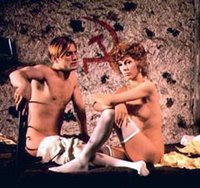 ‘professionalism’ to Morrissey’s directing talent that suggests the style of the earlier films was more mannered and intentional than critics assumed. These two films manage to simultaneously fit in with the early 70’s genre of European erotic horror, while at the same time poking fun at them. There's lots of naked women standing around what looks like uncomfortably cold sets, and an occasional flash of cult icon Joe Dellesandro's member. Flesh for Frankenstein was originally shot in 3-D, an effect used mainly here to thrust bloody organs at the viewer. For fans of the legendary Udo Keir, it never got better than this; he's fascinating to watch in these movies, first as the mad doctor obsessed with finding the perfect 'nasum', then as an effete aristocrat constantly foiled in his search for a remaining virgin.
‘professionalism’ to Morrissey’s directing talent that suggests the style of the earlier films was more mannered and intentional than critics assumed. These two films manage to simultaneously fit in with the early 70’s genre of European erotic horror, while at the same time poking fun at them. There's lots of naked women standing around what looks like uncomfortably cold sets, and an occasional flash of cult icon Joe Dellesandro's member. Flesh for Frankenstein was originally shot in 3-D, an effect used mainly here to thrust bloody organs at the viewer. For fans of the legendary Udo Keir, it never got better than this; he's fascinating to watch in these movies, first as the mad doctor obsessed with finding the perfect 'nasum', then as an effete aristocrat constantly foiled in his search for a remaining virgin. Mark of the Devil: 1969, directed by Michael Armstrong
Mark of the Devil: 1969, directed by Michael ArmstrongAnother Udo Kier picture, this time set during the inquisition. A brutal, terrifying look at the use of sexual dysfunction masked as religious devotion. The local witch hunter singles out attractive young maidens - and anyone noting this pattern- for interrogation in his torture chamber. The Grand Inquisitor (Herbert Lom) arrives, but turns out to be just as evil and twisted. Grim.
 Vampyros Lesbos: 1970, directed by Jesus Franco
Vampyros Lesbos: 1970, directed by Jesus FrancoThe most popular and widely known of his films, this is the ideal starting place with anyone not familiar with the Master of erotic horror. Like all of his work, beautifully shot, perfectly score, intensely erotic and having a plot that makes little or no sense. At his best, Jesus Franco is equal to Federico Fellini as a visual director. At his worst…well, there’s lots of hot naked women running around, at least.
 Alucarda: 1975, directed by Juan Lopez Moctezuma
Alucarda: 1975, directed by Juan Lopez MoctezumaWritten and directed by a fellow member of Aejandro Jodorowsky’s Panic Movement, this is an interesting hybrid of art and horror. Like the best of horror films, this gets a lot out of a pretty meager budget, the set designs in particular offering a unique visual setting for this tale of convent girls drawn into the clutches of Satan. While not quite as good as his earlier “Mansion of Madness”(which isn’t a horror movie), this is still a good time. Tino Romero’s turn as the black-clad, morbid title character makes this a particularly good selection for any little Goths out there.

Die! Die! My Darling! (aka The Fanatic):1965, directed by Silvio Narizzano
Often imitated, never equaled story of deranged woman who imprisons her dead son’s widow. Talluah Bankhead’s final screen appearance, as the incestual, religious fanatic mother-in-law. If you really want to get on the nerves of those around you, sing the Misfits song of the same name during the opening credits. Extra bonus: a young Donald Sutherland as the retarded gardener.
 God Told Me To: 1976, directed by Larry Cohen
God Told Me To: 1976, directed by Larry CohenNew Yorkers are suddenly snapping, going on killing sprees. Afterwards, all they can offer by way of an explanation is to repeat the film’s title. When watched in the right state of mind, this movie can be really, really far out. Jesus, who is also an alien, lives in a boiler room, remotely ordering people to go out and kill. A hirsute police officer, who is also an alien, and also either Jesus or the Devil (I’m still not sure), must do battle with the basement Christ. I’ve watched this movie several times, including with Cohen’s audio commentary, and I am still completely in the dark about what it means. For those interested, there’s the added fun of seeing a young Andy Kaufman shoot a bunch of cops at the St. Patrick’s Day parade.
 Horror Express: 1973, directed by Eugenio Martín
Horror Express: 1973, directed by Eugenio MartínAlong with Vincent Price, Boris Karloff and Lon Chaney, you’re guaranteed at least an enjoyable time from any horror movie pairing Christopher Lee and Peter Cushing. This film, about a frozen monster coming back to life as it is being transported across turn of the century Siberia, is one of their best. About two thirds through, the film is hijacked by Telly Savalas’ arrival as a womanizing, vodka-soaked Cossack investigating the murders. Telly at his manic best.
 The Passion of Ayn Rand: 1999, directed by Christopher Menaul
The Passion of Ayn Rand: 1999, directed by Christopher MenaulGullible college students become mindless zombies when they read the twisted writings of The Marquis De Sade, who has come back to life as a Neo Con succubus that feeds off their half-literate brains.
 The Driller Killer: 1979, directed by Abel Ferrara
The Driller Killer: 1979, directed by Abel FerraraSelf-centered roommates, unpaid bills and a new wave band endlessly practicing in his building slowly wear down the nerves of Soho artist Reno (played by Ferrara). The mockery of an art collector drives him over the edge, and a power tool rampage ensues. Despite the gory premise, this is more of an underground art film than a standard slasher flic, an authentic document of gritty, heroin era New York City, before it became a safe tourist destination.
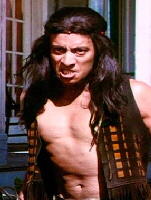 I Drink Your Blood: 1970, directed by David E. Durston
I Drink Your Blood: 1970, directed by David E. DurstonThe evil of hippies revealed! A group of flower-power Satanists terrorize, rape and kill their way across the land, until a young boy serves them rabies infected pie. Gory and goofy...like the 1960s.
 Alice Sweet Alice (aka Communion): 1976, directed by Alfred Sole
Alice Sweet Alice (aka Communion): 1976, directed by Alfred SoleI’ve heard a million times from friends who grew up Catholic how scared they were as children when they first saw “The Exorcist”. For the rest of us, this is the film that gave us nightmares ABOUT the Roman Catholic Church. A little girl (Brooke Shields!) is burned alive on the day of her first communion, a senile old priest demands soup, a demented spinster obsesses over her confessor, someone is nailed to the floor in Christ position…this film was my first introduction to the Roman faith, and I had papal-themed nightmares for years after. The ugliest thing about this movie, though, is Alice’s down stairs neighbor, Mr. Alphonso, a morbidly obese, bald, lisping pedophile in dirty underwear and an apartment full of cats. A lot of adjectives for a lot of freak.
 The Brotherhood of Satan: 1971, directed by Bernard McEveety
The Brotherhood of Satan: 1971, directed by Bernard McEveetyA cabal of geriatric Satanists abducts children so they can inhabit their bodies. Strother Martin as the devil's high priest! Enough said.
 Two Thousand Maniacs: 1964, directed by Herschell Gordon Lewis
Two Thousand Maniacs: 1964, directed by Herschell Gordon LewisNo list of horror movies would be complete without an H.G. Lewis film. While all of his titles deserve equal mention, this is the most widely loved of all his work. The inhabitants of Pleasant Valley, a small southern town that was the site of a massacre one hundred years before, torment and kill tourists on the centennial. If you’ve never seen anything by the Godfather of Gore, this is the perfect place to begin. If you have already seen it, then I suggest you recommend it to someone who hasn’t. Strangely, I’ve found that even people who aren’t that fond of spatter horror films still get a kick out of this one. Granted, all the people I’ve shared this movie with hail from the North; I don’t know that depicting loyalty to the Confederacy as the act of psychopaths would be well-received south of the Mason/Dixon…
 The Masque of the Red Death: 1964, directed by Roger Corman
The Masque of the Red Death: 1964, directed by Roger CormanOkay, this is hardly an unknown movie, but I thought it might be fitting to end my list with one of my all-time favorite films. This really is a great picture, one that shows that Corman could be an inventive, original director when the mood struck. It’s also his most audacious thematically; the perfect logic of Satan-worshipping Prince Prospero (Vincent Price) when he debates pure, devout Francesca (the beautiful Jane Asher) about theology is so well argued that it’s difficult to find fault with his reasoning. The fourteenth century world the film inhabits is pretty wretched, and Prospero’s argument that God is long dead seems plausible when examining their landscape of disease and suffering. By the end of the film, Francesca seems to agree. Even after all the murder and cruelty she’s seen Prospero display -including killing her father- she seems genuinely sad to leave his company. It’s a subtle moment many viewers miss, but for several long seconds she looks longingly at her evil captor, until she finally succeeds in turning (tearfully) away. Plus, how can you pass up a movie where Patrick Magee is tied-up in an ape suit, then set on fire by an angry dwarf? I will be watching this classic on Halloween night.
I could go on and on listing weird and wonderful horror movies, but if I don’t stop, I won’t get this posted before Halloween. But in case you’re looking for alternatives to the ones listed, here are a few obvious holiday standards: Basket Case (1982; Henenlotter): Bloody Pit of Horror (1965; Pupillo); Black Sunday (1960; Bava); Spider Baby (1964/68;Hill); Daughters of Darkness (1971; Kümel). Obviously, there are more forgotten than remembered, and this list is certainly not meant to be definitive. Please feel free to add your favorite horror films to my message board.
Labels: cult movies, euro-sleaze, horror, lost classics, sexpoitation


